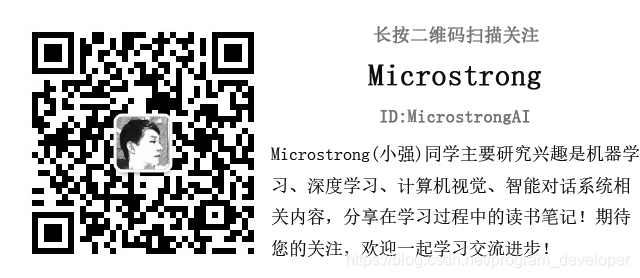Tensorflow學習之Autoencoder(三)圖片降維的結果展示
阿新 • • 發佈:2019-01-02

實現功能:
在自編碼器(autoencoder)中有編碼器(encoder)和解碼器(decoder)。我們只看
encoder壓縮的過程,使用它將一個數據集降維到只有兩個Feature時,將資料放入一個二維座標系內。
思路:
我們只顯示 encoder 之後的資料, 並畫在一個二維直角座標系內。做法很簡單,我們將原有 784 Features 的資料壓縮成僅剩 2 Features 的資料。
實現程式碼:
import tensorflow as tf import matplotlib.pyplot as plt # Import MNIST data from tensorflow.examples.tutorials.mnist import input_data mnist = input_data.read_data_sets("/tmp/data", one_hot= False) # Visualize decoder setting # Parameter learning_rate = 0.01 # 0.01 this learning rate will be better! Tested training_epochs = 10 # 10 Epoch 訓練 batch_size = 256 display_step = 1 # Network Parameters n_input = 784 # MNIST data input (img shape: 28*28) # tf Graph input(only pictures) X = tf.placeholder("float",[None, n_input]) # hidden layer settings n_hidden_1 = 128 n_hidden_2 = 64 n_hidden_3 = 10 n_hidden_4 = 2 weights = { 'encoder_h1': tf.Variable(tf.truncated_normal([n_input, n_hidden_1],)), 'encoder_h2': tf.Variable(tf.truncated_normal([n_hidden_1, n_hidden_2],)), 'encoder_h3': tf.Variable(tf.truncated_normal([n_hidden_2, n_hidden_3],)), 'encoder_h4': tf.Variable(tf.truncated_normal([n_hidden_3, n_hidden_4],)), 'decoder_h1': tf.Variable(tf.truncated_normal([n_hidden_4, n_hidden_3],)), 'decoder_h2': tf.Variable(tf.truncated_normal([n_hidden_3, n_hidden_2],)), 'decoder_h3': tf.Variable(tf.truncated_normal([n_hidden_2, n_hidden_1],)), 'decoder_h4': tf.Variable(tf.truncated_normal([n_hidden_1, n_input],)), } biases = { 'encoder_b1': tf.Variable(tf.random_normal([n_hidden_1])), 'encoder_b2': tf.Variable(tf.random_normal([n_hidden_2])), 'encoder_b3': tf.Variable(tf.random_normal([n_hidden_3])), 'encoder_b4': tf.Variable(tf.random_normal([n_hidden_4])), 'decoder_b1': tf.Variable(tf.random_normal([n_hidden_3])), 'decoder_b2': tf.Variable(tf.random_normal([n_hidden_2])), 'decoder_b3': tf.Variable(tf.random_normal([n_hidden_1])), 'decoder_b4': tf.Variable(tf.random_normal([n_input])), } # Building the encoder def encoder(x): layer_1 = tf.nn.sigmoid(tf.add(tf.matmul(x, weights['encoder_h1']), biases['encoder_b1'])) layer_2 = tf.nn.sigmoid(tf.add(tf.matmul(layer_1, weights['encoder_h2']), biases['encoder_b2'])) layer_3 = tf.nn.sigmoid(tf.add(tf.matmul(layer_2, weights['encoder_h3']), biases['encoder_b3'])) layer_4 = tf.add(tf.matmul(layer_3, weights['encoder_h4']), biases['encoder_b4']) return layer_4 # Building the decoder def decoder(x): layer_1 = tf.nn.sigmoid(tf.add(tf.matmul(x, weights['decoder_h1']), biases['decoder_b1'])) layer_2 = tf.nn.sigmoid(tf.add(tf.matmul(layer_1, weights['decoder_h2']), biases['decoder_b2'])) layer_3 = tf.nn.sigmoid(tf.add(tf.matmul(layer_2, weights['decoder_h3']), biases['decoder_b3'])) layer_4 = tf.nn.sigmoid(tf.add(tf.matmul(layer_3, weights['decoder_h4']), biases['decoder_b4'])) return layer_4 # Construct model encoder_op = encoder(X) # 128 Features decoder_op = decoder(encoder_op) # 784 Features # Prediction y_pred = decoder_op # After # Targets (Labels) are the input data. y_true = X # Before # Define loss and optimizer, minimize the squared error cost = tf.reduce_mean(tf.pow(y_true - y_pred, 2)) optimizer = tf.train.AdamOptimizer(learning_rate).minimize(cost) # Launch the graph with tf.Session() as sess: # tf 馬上就要廢棄tf.initialize_all_variables()這種寫法 # 替換成下面: sess.run(tf.global_variables_initializer()) total_batch = int(mnist.train.num_examples/batch_size) # Training cycle for epoch in range(training_epochs): # Loop over all batches for i in range(total_batch): batch_xs, batch_ys = mnist.train.next_batch(batch_size) # max(x) = 1, min(x) = 0 # Run optimization op (backprop) and cost op (to get loss value) _, c = sess.run([optimizer, cost], feed_dict={X: batch_xs}) # Display logs per epoch step if epoch % display_step == 0: print("Epoch:", '%04d' % (epoch+1), "cost=", "{:.9f}".format(c)) print("Optimization Finished!") encoder_result = sess.run(encoder_op, feed_dict={X: mnist.test.images}) plt.scatter(encoder_result[:, 0], encoder_result[:, 1], c=mnist.test.labels) plt.show()
實現結果:

實驗結果分析:
我們知道mnist資料集中有10個數字,也就是有10類資料,每個數字是以28*28(784)維圖片展示的。我們在上面的實驗中將所有資料降維到2維資料,並展示在二維資料座標中。從圖1中我們可以看到,所有資料降到2維之後,還是可以把相同類別的資料歸到同一類中。在圖1中,同樣顏色的點,代表分到同一類的資料(Lebel相同)。在這個實驗中自編碼器(autoencoder)類似於PCA,起到了降維的作用。
Reference:
